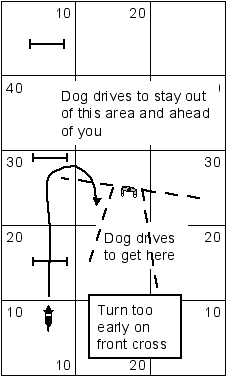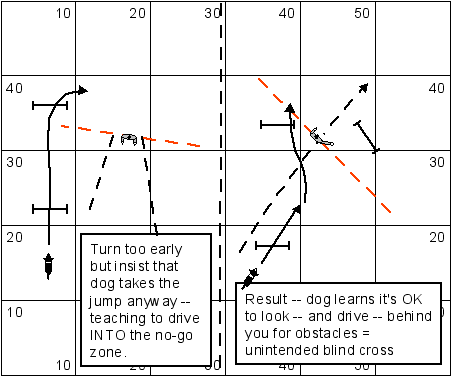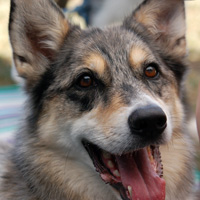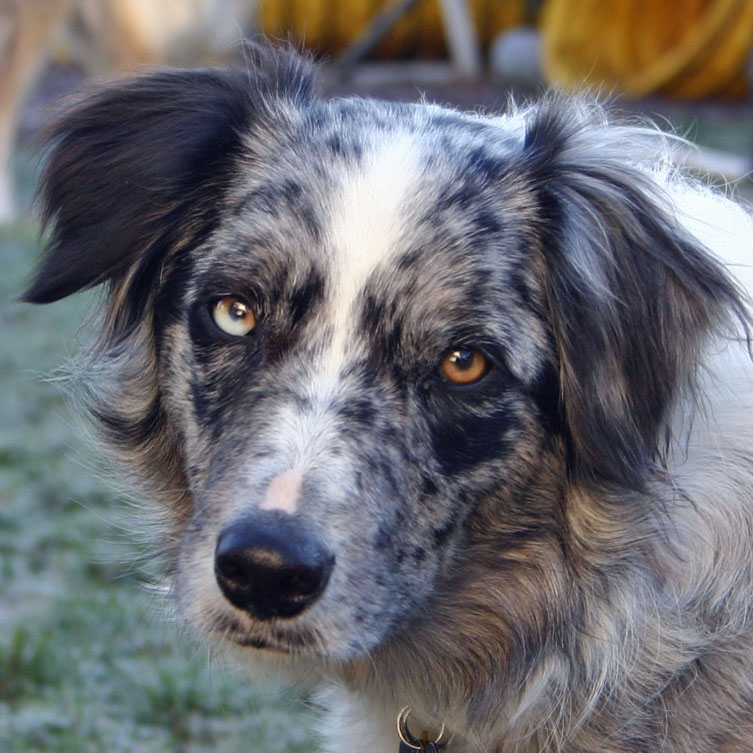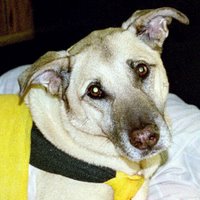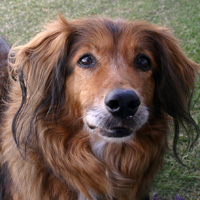SUMMARY: We'll have fun fun fun till our human puts the goodies away.
Last week, Tuesday and Thursday evenings, I had the opportunity to do something that I almost never do any more: Sit in over an hour's worth of ugly traffic to make a 35-mile drive.
Ha! But that's not the only thing. I used to teach Remington tons and tons of tricks. I loved it. Loved adding to his ever-growing list of things he could do. The usual stuff: Hold a biscuit on his nose and walk, sit up, wave, limp, jump onto anything I pointed to, say his prayers, be embarrassed, count, do figure 8s around my legs, play the tuba... you know. Except for playing the tuba, not really. But agility gradually took over my brain. Now when I want to fine-tune something, it's usually weave entries or contact speed or rear crosses or playing the saxophone.
Ha! Kidding about the saxophone, too, none of my dogs play instruments. But now that you mention it, that would be a good trick to work on.
Anyway, I audited two nights of
Silvia Trkman's tricks seminar. Tricks were geared towards stretching, balance, targeting, and other nifty things that are extremely useful to agility dogs (but are fun for ANY dog). A Bay Team member has a lovely indoor facility (
Javadog Training Center), which is extremely rare here in sunny California, and so we could work on a cold, dark winter's evening in a beautiful indoor setting.
She gave
brief descriptions of each trick, explained a little about how to shape the trick, then let all the participants work on the trick for about 15 minutes. She said that an "operant" dog (that's actually Susan Garrett's term, not one Silvia used) should be able to learn any one of her tricks in about that amount of time. Several dogs did pretty good; several others really had little or no experience shaping and few or no tricks.
At least
my dogs are fairly operant because I dink around with shaping them to do stuff from time to time.
Because I had just picked up Tika from the vet the first night, she and Boost were there with me, hidden in the back of the room where we wouldn't get in the way of the paid participants. So I took the opportunity to
work on my own dogs with some of the tricks without assistance from the instructor.
I think I'm pretty good at
shaping. Not an expert, but I can coax some things pretty quickly out of my dogs. Sometimes I get stuck--more in a moment--and half of being able to shape well is to figure out how to get around your dog's mental blocks.
One trick was to have the dog
grab a pole with her front leg and hold it (picture them sitting up and doing this with a teddy bear. Very cute). In one session, I made great progress with both Tika and Boost in the time others were working with just their one dog. They weren't quite holding it yet, but I was out of time.
Another one I worked on a little was having Tika do a
figure 8 BACKWARDS around my legs. I picked her for this one because she already does
backwards on command (I use "beep beep beep" like for a truck backing up) and she already does
figure 8s around my legs. This was tough to get started. Silvia had suggested standing against a wall or corner so that, when the dog backs up, the only place she can go is through your strategically placed legs. Well, Tika backed up against the wall and stayed there. Took me a while to figure out what angle of approach worked and what stance of my own helped. I got her to do one backup through my legs two or three times, and I was sweating at the end of it.
Another I worked on was having Boost
ricochet off my torso. Silva started by having people teach the dog to jump onto your lap and then into your arms while you're standing. The trick for that, she said, was to get the dog to be turning his head as he arrived at you, because it's much easier to catch a dog who's sideways to you than coming straight on. Lucky me, when I taught Boost to jump into my arms, she figured out that turning bit on her own. So I just needed to expand on that.
I started by placing myself at an angle on a chair (no actual lap) and encouraging her to jump up, then throwing a toy and telling her to get it as she turned. Gradually I stood up more and more, continuing to throw the toy but still with a slight bend in my legs so she had somewhere to land and still catching her slightly, but not impeding her in immediately going for the toy. We made good progress, I think, but I worked up a sweat on that one, too.
The most popular tricks that she had people start on--and that I think we're going to see a lot more of in our area--were the
dog standing on 2 legs. Sure, on their hind legs, that's pretty easy to shape. But how about doing a handstand? As it turns out, shaping that's not too bad, either. But how about standing on the legs
on one side of the body? Or
kittycorner legs? She demonstrated with her own Pyrenean Shepherd, La. So wonderful to watch! And now I have ideas on how to shape it. (E.g., for kittycorner, you teach one rear leg up and then while they're doing that, you ask for a shake on the opposite front leg, assuming they already know that, too.)
Silvia didn't go into this sort of detail, but did mention in conjunction with other things some of the
key pieces in shaping (for anyone who hasn't taken a seminar in shaping or read a good book on it) include:
* Breaking things down into really really tiny pieces, as small as needed to make progress.
* Being able to reward the dog regularly, every few seconds, or the dog can become frustrated or bored and progress halts.
* Timing. You have to click (or say "yes!") at the instant that the behavior you want occurs, not a moment before or after.
* Patience to start with, for the dog to do *anything* *anywhere near* what you want.
* Click for behavior, reward for position.
For example, another one I worked on with Boost was
walking backwards. To shape this behavior, I started with the dog standing up facing me (I was sitting for better view of her feet) and waited for the tiniest movement backwards. People often want too much. I start with half a fraction of an inch backwards with even one foot, which dogs usually do fairly quickly as they're looking at you and figuring out what you want. So I'm watching her feet, not any other part of her body, so I can click at the instant that any foot moves backwards a millimeter.
Immediately after the click, I reward for position: I don't want her to come towards me, as that defeats the lesson of going backwards away from me. So I toss a treat between her front legs, so that to get it, she has to take another step backwards. When she does that (even if she doesn't have the first treat yet), I click again and toss another treat between her front legs. If the dog cooperates, you can be clicking/treating constantly for EVERY step backwards until she gets too far away to throw the treats accurately.
I had Boost backing up there in the back of the classroom within just a few minutes.
You can also teach a dog by
leading or luring , for example by luring them forward with a piece of food. I taught Remington to back up wayyyy back when by walking towards him so that he had to back up. I think that makes the dog pay more attention to what I'm doing and wait for information from me, when what I want in a tricks dog (AND in an agility dog) is one who thinks about his body and his movements and figures things out for himself so I don't have to micromanage him every step of the way. I started working with clicking and shaping when Remington was several years old, and he loved it, too.
About
dogs' mental blocks:
Tika confounded me with
backing up (when I taught her probably 5 or 6 years ago) because every time I tossed a treat between her front legs, she stepped forward into a turn to go back and get it, so I couldn't get the constant click-click. I had to find creative ways to keep her from doing that. Like put her next to a wall on the side that she preferred to turn. I think I even set up a couple of chairs at one point on either side of her. I had to use the right kind of treat and practice so that it landed JUST between or barely behind her front legs so that it was easier for her to get it just standing there or moving one foot backwards. It was a challenge, where Boost was a breeze.
Yesterday I was working on teaching both girls to
nest one food bowl inside another. (This is a Silvia trick from one of her videos; Boost's breeder Tammy was there and her dogs were doing it, so I came home with that idea.) Both dogs already pick up their food bowls and drop them near me, so I figured this would be a cakewalk. Tika picked it up pretty quickly--it is so amazing to see the dog figuring out the space that she needs to maneuver through to make it happen.
Boost, however, has made a concerted effort to drop the bowl anywhere the other bowl was NOT. It has been challenging, and I will continue to work to find clever ways to get her to drop the bowl under her own power nearer and nearer to the other bowl. I haven't figured it out yet, and neither has she. It's always something. It's a good mental workout for both of us.
And you never know which dog will get stuck with what--Boost, after all, was the dog who learned how to
get into a box a couple of years back (this was also one of Silvia's tricks at the seminar) by watching me shape Tika into doing it! That dropped my jaw in amazement--after 5 minutes with Tika, when I called Boost over, she immediately jumped into the box.
Anyway--if you want ideas on tricks and to see many of the tricks she introduced at her seminar and a squillion others, visit
Silvia's video page. I love watching her videos. She obviously loves her dogs and her dogs love doing the fun tricks with her.
Updated an hour later: I took my camera with me both nights but took only the one photo. Fellow Bay Teamer Team Whisner took photos, however;
see her blog post.Labels: clicker, seminars, shaping, Silvia Trkman, tricks
Complete list of labels

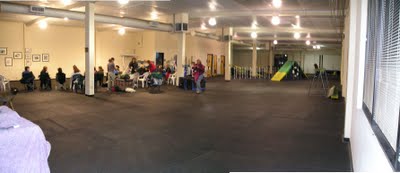
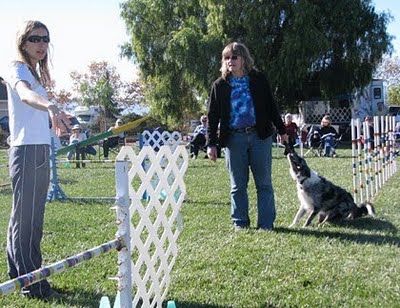
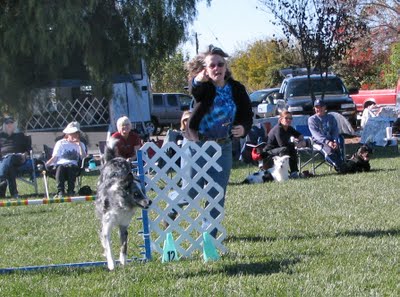
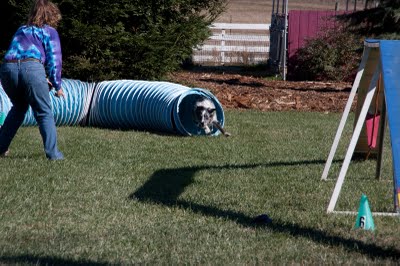
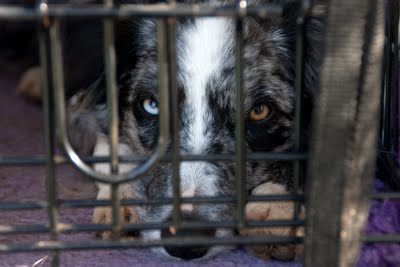
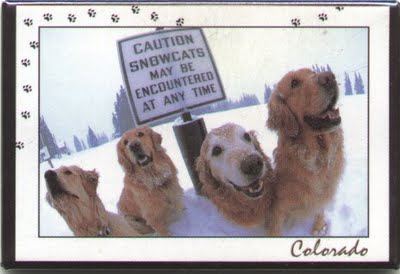
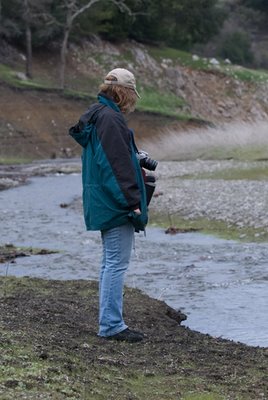
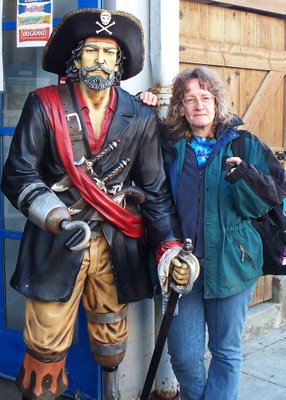
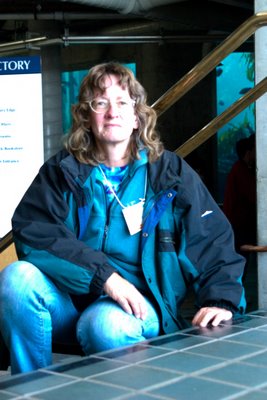
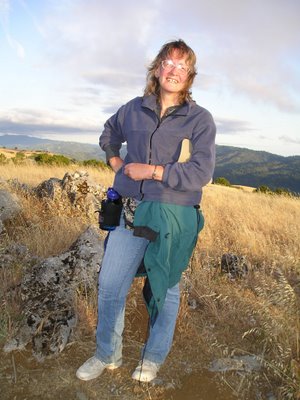

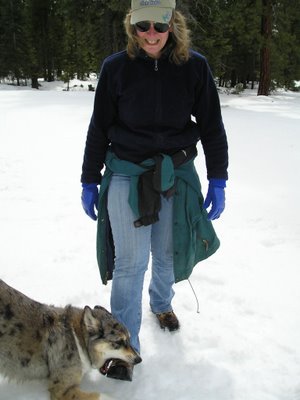
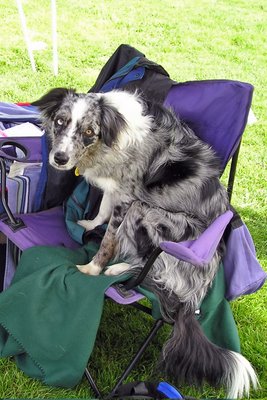
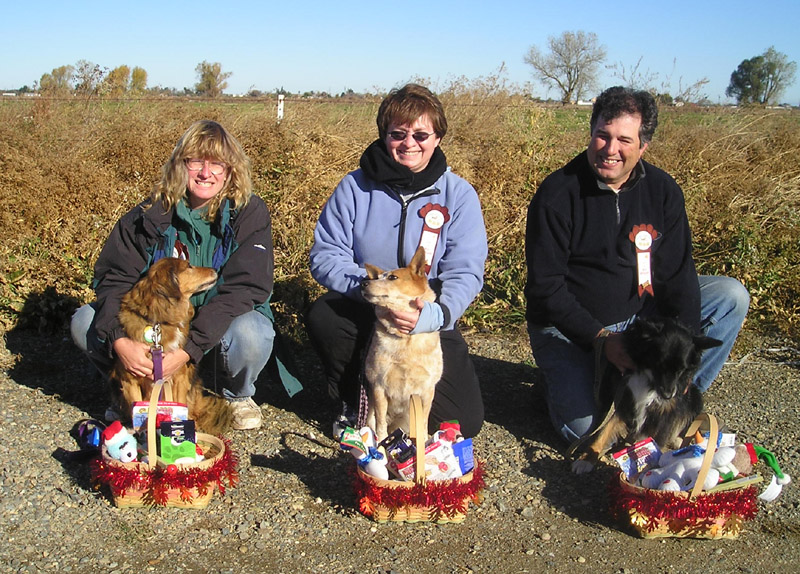
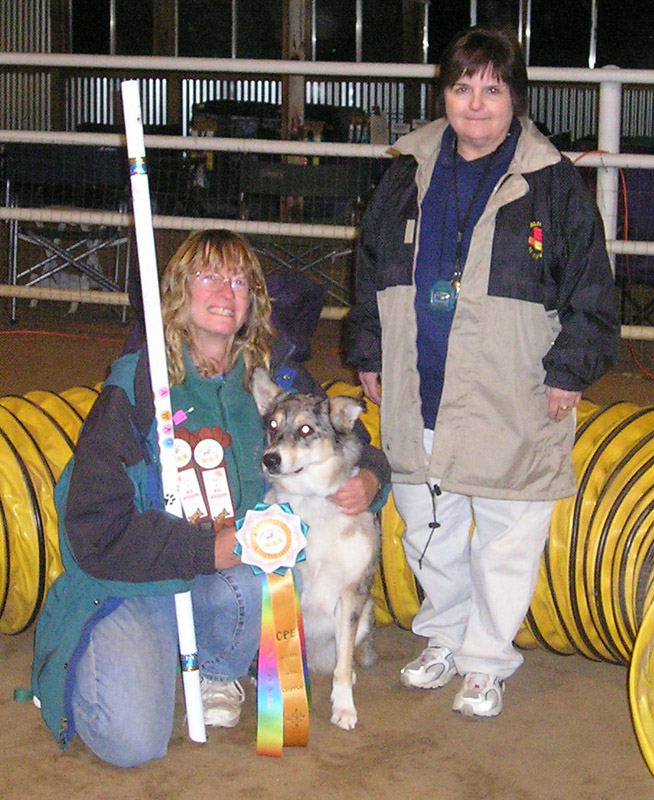
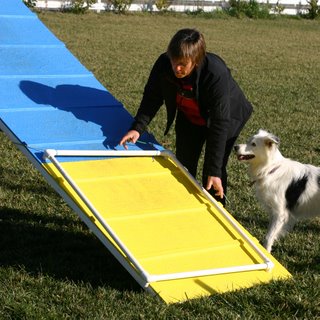
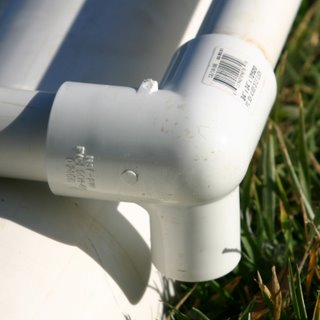
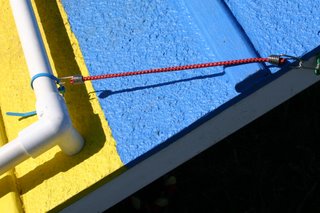
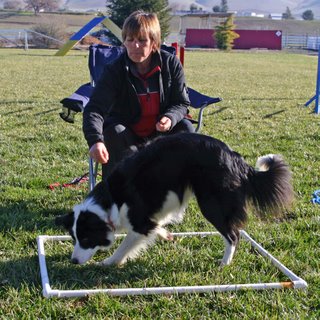
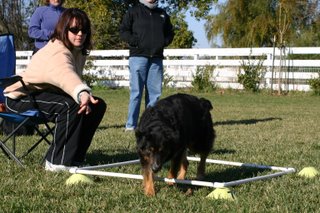
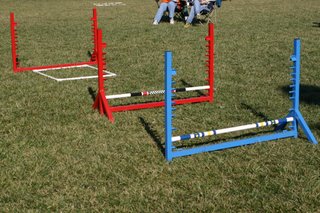
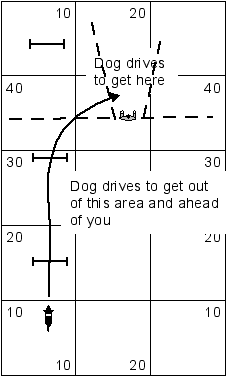 I basically understand the "no-go-zone" or the "blind cross zone" or various other names for it--essentially, if you draw a line extending out through your shoulders to either side of you, the dog should never go into the zone behind that; they should be driving at all times to get into the zone directly in front of you, loosely defined by the same line but more specifically directly in front of you in the direction you're going.
I basically understand the "no-go-zone" or the "blind cross zone" or various other names for it--essentially, if you draw a line extending out through your shoulders to either side of you, the dog should never go into the zone behind that; they should be driving at all times to get into the zone directly in front of you, loosely defined by the same line but more specifically directly in front of you in the direction you're going.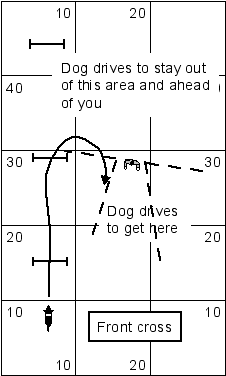 In theory, this is why front crosses work--you direct your body forward until the dog is committed to the obstacle ("committed" meaning there is nothing you can do to pull them off that obstacle), then turn your body, so dog wants to drive out of no-go zone and drive to get in front of you again.
In theory, this is why front crosses work--you direct your body forward until the dog is committed to the obstacle ("committed" meaning there is nothing you can do to pull them off that obstacle), then turn your body, so dog wants to drive out of no-go zone and drive to get in front of you again.